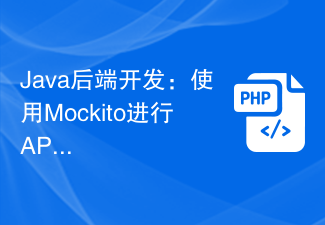Found a total of 8 related content

How to unit test Java functions with Mockito?
Article Introduction:Steps to test Java functions using Mockito: Add Mockito dependencies. Create mock objects and set mock behavior. Call the function to be tested. Assert the expected behavior of a function. Use verify() to verify simulated interactions.
2024-04-27comment511

Java backend development: API unit test mocking using Mockito
Article Introduction:With the popularity of the Internet, Java back-end development has become an important field. In the development process, unit testing is a very critical step, and Mockito is an excellent API unit test simulation tool. This article will introduce how to use Mockito in Java back-end development. What is Mockito? Mockito is a Java framework that provides API unit testing simulation capabilities in the form of Mock objects. Mock objects refer to some virtual objects whose behavior is set by us
2023-06-17comment 01186

java框架中使用Mockito和PowerMock进行单元测试和集成测试
Article Introduction:在Java开发中,Mockito和PowerMock用于单元测试和集成测试。Mockito可用于mocking方法调用,而PowerMock可用于模拟静态和私有方法。通过使用Mockito和PowerMock,您可以对Java代码进行全面有效的测试,确保其可靠性和可维护性。
2024-06-10comment 0114

Mockito and JUnit unit testing framework: how to collaborate
Article Introduction:Mockito and JUnit join forces to improve unit testing efficiency: Mockito allows the creation of test stubs and mock objects to verify the expected interactions of the code. JUnit provides a framework to make test writing and running easier. When used together, you can create highly readable and maintainable tests that effectively verify the correctness of your code.
2024-04-18comment342

How to use JUnit and Mockito for test-driven development in PHP
Article Introduction:As software development continues to advance, test-driven development (TDD) has become an increasingly popular development model. In the process of TDD, testing becomes the core of the development process, and JUnit and Mockito are two commonly used testing frameworks. In PHP development, how to use JUnit and Mockito for TDD? A detailed introduction will be given below. 1. Introduction to JUnit and Mockito JUnit is a testing framework for the Java language. It can help Java
2023-06-25comment 0458

How to use Mockito for Java unit testing
Article Introduction:Introduction to Mockito When calling the method of a mock object, the real method will not be executed, but the default value of the return type, such as object returns null, int returns 0, etc. Otherwise, the method is specified by specifying when(method).thenReturn(value) return value. At the same time, the mock object can be tracked and the verify method can be used to see whether it has been called. The spy object will execute the real method by default, and the return value can be overridden through when.thenReturn. It can be seen that as long as mock avoids executing some methods and directly returns the specified value, it is convenient for other tests. Service test cases require dependencies junitjunit4.1
2023-04-19comment 01307

How do annotations in the Mockito framework simplify stub generation and verification?
Article Introduction:Mockito framework annotations simplify the stub generation and verification process: @Mock: automatically generate and manage mock objects. @Captor: Capture the parameter value passed to the mock method. @InjectMocks: Automatically inject mock objects into the class under test. @Spy: Create some stub objects and retain the original method implementation.
2024-05-06comment 0835

Test-driven development using JUnit5 and Mockito
Article Introduction:Test-driven development (TDD) is a software development methodology in which tests are written before the actual code. TDD has gained considerable attention due to its emphasis on code quality and maintainability. This article explores how to implement TDD effectively using JUnit5 and Mockito, two powerful frameworks in the Java ecosystem. What is test-driven development? Test-Driven Development (Test-Driven Development) is an iterative development process in which developers first write test cases for new functions or features, then write the minimum amount of code to pass the test, and finally refactor the code to optimize it. This approach enhances the design, reduces errors, and improves the overall maintainability of the code. Understanding JUni
2023-08-19comment 01095







